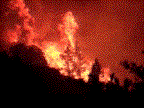FOREST FIRE UPDATES
ONTARIO MINISTRY OF NATURAL RESOURCES
*********************** East Fire Region Situation Update
Friday, July 21, 2006 – 12:00
HIGHLIGHTS:
• five new forest fires yesterday
DETAILS:
There were five new forest fires yesterday in the following areas: three in Sault Ste Marie, and one each in Chapleau and Wawa. There are currently 30 active forest fires in the Chapleau, Hearst, Cochrane, Parry Sound, North Bay, Sault Ste. Marie, Sudbury, Timmins and Wawa areas. No problems are anticipated with these fires at this time.
As of April 1st 2006, there have been 329 forest fires in the East Fire Region.
There are currently 16 FireRanger crews from the East Fire Region in the West Fire Region assisting with their escalated fire situation.
As a result of a major wind storm that passed through parts of eastern Ontario this past Monday, many communities were affected by damaging winds. The Ministry of Natural Resources would like to remind public, especially in those areas, that before burning any debris from the major storm event check with your municipality to be advised of their burning regulations. Please use extreme care and caution with outdoor fires. Never leave your fire unattended and make sure it is completely extinguished before leaving. By eliminating human caused fires that result from carelessness the Ministry of Natural Resources can focus its resources on responding to new lightning caused forest fires.
********************** Provincial Fire Numbers
Fire Yesterday:
31 new fires 151 active fires 44 not under control 17 being held 17 under control 17 out 3 being observed
Active fires:
151 active fires 65 not under control 25 being held 35 under control 26 being observed It was another busy day yesterday. Although not as many starts as Wednesday and we have slightly fewer active fires.
We still have crews and aircraft spread from Pickle Lake in the west to Parry Sound in the east.
We continue to get zonal flows (ridge, front, ridge) that drop rain only in the centre of the storms and throw lightning across the front. With over 80,000 lightning.
There is a possibility of scatter rain Monday bringing 10 mils or so.
Fires to date (11:00 Jul 21): 950 – 14881 ha
Fires to date last year 841 – 24,891ha
West Fire Region – Fires of Note
SLK 38 - 650 ha near to community of Kingfisher
SLK 44 – 250 ha only a couple of kilometres from the community of Angling Lake
DRY 79 – 450 ha threatening values in Eagle Lake near town of Vermillion Bay. An Incident Management team has been assigned to this fire. They had success yesterday burning our fuels to natural boundaries and this fire is in better shape today although it is 1,000 ha
There are currently nine fires in Quetico will and any new fires will be actioned as the fire indices are too high. They add up to 2,091 ha with the largest at 909 ha. No problems anticipated with four of the fires but the others are showing rank 2-3 behaviour.
Clusters of fires in Dryden, Kenora, Greenstone, and Sioux Lookout.
East Fire Region – Fires of Note
One fire of note yesterday north of Pukasaw National Park spotted by a park fire crew on a recon flight with their gear. It eventually took four aircraft and five crews to hold at 15 ha. There are lots of values in the area including timber, Hemlo mines, the communities of Pic River and Heron Bay.
Other Problem Fires
Note: Ontario is currently the hotspot nationally with the most new starts and the highest hazard
BC – 2 11,000 ha fires – the situation on these fires continues to improved although BC is again requesting out of province assistance as their staff timeout.
MB – 3 fires – only one is out of control (with limited action response)the other is being held
Minnesota - The Cavity Lake fire in Minnesota is directly south of east boundary of Quetico. This is a complex fire burning near values and in blowdown fuels. The Forest Service estimates this fire could grow to 30,000 ha. It is currently Size: 28,500 acres. The Pacific Northwest National Incident Management Team 2 arrived yesterday and took over management of the Cavity Lake Fire at 6:00 AM this morning. Approximately 274 personnel are currently engaged in fighting the Cavity Lake fire. The majority of activity is still being conducted by air resources. These include: 3-Type 1 helicopters, 2-Typ 3 helicopters, 2-CL 215 (water scoopers), 2- Beaver. Out Of Province Deployments (OOP)
MNR will not be sending replacements or filling any resource requests until the anticipated fire load has passed.
An ignition team two water bombers and agency rep. are working the Minnesota fire. In Province Resources
From Alberta - three CL215s and one bird dog with an air attack officer and trainee
From Saskatchewan - two CL215s and one bird dog with an air attack officer
From Northwest Territories - two CL215s and one bird dog with an air attack officer
Quebec - two C 415s from Quebec and a bird dog
6 IA from Alberta and 4 division supervisors (31 people altogether)
33 intermediate and 22 medium and 3 heavy helicopters on casual hire.
We could use 8-10 more at this time but it is unlikely as they are in short supply Quickstrike arrangements have been activated with Manitoba, Minnesota and Quebec.
Resource Requests
MNR has a request in with CIFFC for although most western provinces are recycling their crews after a busy two-three weeks:
The one IM Team from AB was cancelled they needed it there and we determined that we did not need it here so that worked out.
30- 50 IA crews but unlikely before end of the weekend. More tankers requested but unlikely until after weekend.
************************
